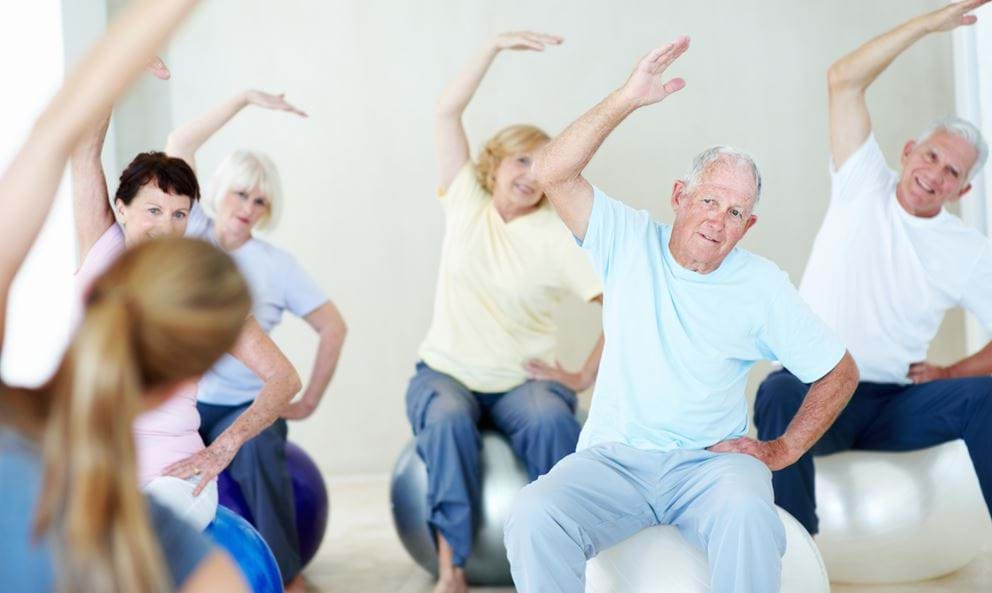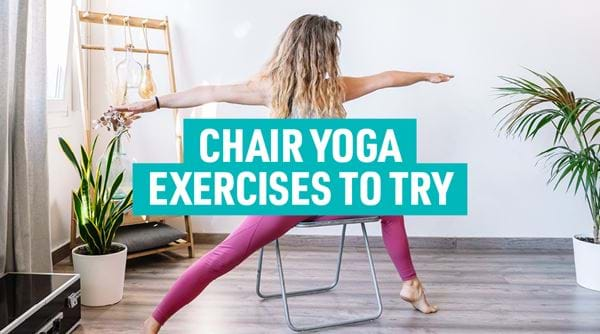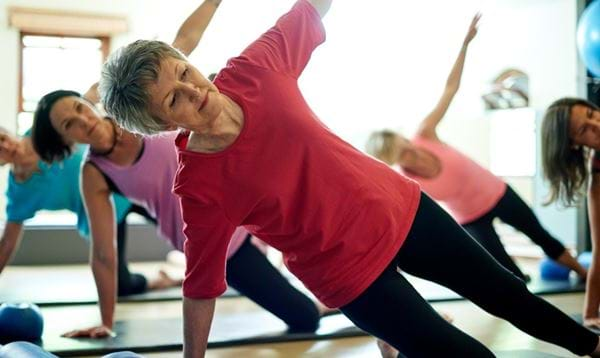Exercise for older adults: Simple exercises to keep you active in your senior years

It's never too late to start your health and fitness journey. Working on your wellbeing, regardless of your age is important. By staying active in your 60s, 70s and beyond, you can lower your chances of developing chronic illnesses such as heart disease, stroke, diabetes, dementia and mental illnesses, and help to prevent back pain. Focusing on your flexibility and balance will become more important as we age, as it can help reduce the risk of falls and injuries by keeping your joints and muscles strong. And, of course, staying active and healthy can help you to stay social and mobile, boosting all elements of your lifestyle as you get older. What sort of exercises should you be doing as a senior? Ideally, you’ll be including a variety of exercise styles in your weekly exercise schedule, including aerobic and cardio exercise (to increase your heart rate), balance and mobility (from stretches) and strength (including some kind of weight to retain muscle mass).
While we highly recommend you incorporate elements of all of the above styles of exercise, don’t force yourself to do workouts you don't feel comfortable with or hate – instead, focus on the types of exercise you can enjoy and be consistent with. Perhaps you enjoy walking or cycling? That’s great – make sure to create a routine you can stick to each week. Maybe swimming has been your favourite relaxing pastime; try to make it to the pool at least a couple of times a week.
Also, it’s important to avoid pushing yourself beyond your ability too quickly. If until now you’ve been fairly inactive, then start at a lighter intensity and frequency before building your way up. If your body doesn’t feel ready to push to the next level, then focus on maintaining a regular exercises routine, even if it’s at a lower intensity.
How much exercise should you be doing as an older adult?
NHS guidelines highlight that adults over the age of 65 should aim to be physically active every day, and in a week should be aiming for around 150 minutes (20 minutes a day) of moderate intensity exercise such as a brisk walk, tennis, cycling or water aerobics, or 75 minutes (just over 10 minutes a day) of vigorous intensity exercise such as jogging, dancing, fast swimming or uphill hiking. You can either split these out across the week or do a few longer workouts, but it’s good to aim for at least a couple of exercise sessions a week. Aim to stand up at least once every hour, or more often if you can, as sitting for long hours at a time has been proven to increase the likelihood of developing diseases.
What exercises are best for older adults?
It’s best to vary your exercise routine and include a range of styles and types of movement, to ensure you’re keeping your whole body supple and strong as you age. Try to pick at least one from each of the following three sections several times a week.
Cardio and Aerobic Fitness
As mentioned above, this is any type of exercises that raises your heart rate and helps to improve the movement of oxygen around the body. Including this type of exercise can help to increase your energy expenditure which can help to keep your weight under control, and at the same time provide a wealth of other health and wellbeing benefits for both your body and mind.
Examples include:
- Walking – if you’re just beginning to get more active then walking can be a great place to start. It’s an excellent opportunity to get some fresh air, or head to the gym and use the treadmill if the weather’s looking too rough. Try to keep the pace up as much as possible, and aim for between 2,000 to 9,000 steps a day (or more if you can). But remember, any movement is better than no movement – the important thing is to just keep going and go for a distance and pace that is comfortable for you.
- Swimming – a perfect low-impact exercise, which puts less pressure on your joints. You can push yourself hard for a few lengths, or have a gentler swim for a longer amount of time. While you’re in the water you can also stretch and move in a variety of ways, including water aerobics, helping to boost your body health without too much impact.
- Cycling – another excellent, lower-impact option, you can enjoy cycling while taking in the sights outside, or on a stationary bike at the gym if you don’t have a bike of your own.
Strength Exercises
As the name suggests, strength exercises focus on improving the power of your muscles and bones, helping to boost endurance and counteract any frailty that can come with aging. These types of exercises can reduce the risk of health issues such as osteoporosis and arthritis, and can help to improve your balance. Start by trying these using just your bodyweight, and as you improve, start introducing light weights to see more benefits.
Examples include:
- Leg raises – an easy starting place that can target your glutes, hip flexors and lower back, leg raises are quick and simple to do either at home or in the gym and are excellent for refining your balance. Stand up and, while leaning on the back of a chair for stability, slowly lift your right leg to the side, keeping your back straight and your toe facing forward. Don’t bend your leg or point your toe. Hold when you feel you have lifted as high as is comfortably possible, before slowly lowering. Repeat several times on one leg, before doing the same with the other leg. Mix things up and target your glutes a little more by trying some back leg raises, which are the same, except you lift your legs straight back behind you.
- Squats – many trainers say squats are their favourite workout movement, as they work more muscles in one go than any other individual exercises. They’re a highly effective way to target your legs, glutes and lower back, improving stabilisation, strength and balance. You don’t need any equipment, although you may want to stand near a chair or wall to steady yourself. Stand with your feet slightly wider than hip distance apart, keep your back straight and bend your knees so you squat closer to the floor. Focus on sending your hips backwards, as you don’t want your knees to be in front of foot level at any point. Aim to reach a point where your hips are just below your knees, or as low as you can comfortably go. Pause briefly, before slowly easing your way up to starting position by powering through your legs and feet. Focus on gripping the floor with your toes as you squat, so you don’t lean too far backwards. Find out more with our How to Squat
- Lunges – ideal for preserving and improving quad strength and those hard-to-reach inner thigh muscles, this is another strength move which helps with balance and mobility. Stand with feet hip width apart and keep a wall or chair nearby in case you need help with balance. Take one step forward with your right leg and lift your left foot until only your toes are on the floor. Keeping your body and back straight, lower your body and bend both legs until your left knee is just a few inches from the floor. Hold for a moment before slowly returning to start position. Find out more with our How to Lunge
If you're looking for workouts for older adults, check out our HIIT for seniors workout plans.
Balance and Flexibility:
There’s a lot of crossover between strength exercises and balance and flexibility exercises, as many of the moves you’ll make in each have similar goals and benefits. However, where the former focuses on boosting the strength of your muscles and bones, the latter focuses more on stretching and improving circulation and blood flow. These sorts of workouts can help to prevent falls and injuries by keeping your joints supple and sturdy. While you can do many stretches at home by yourself, you can also head to the gym to try some classes – that way you’ll boost your flexibility in a fun and sociable environment under the guidance of expert teachers.
Examples include:
- Yoga – a gentle, low impact style of exercise, yoga focuses on holding a series of postures and stretches, while devoting time to thinking about relaxation and breathing. It’s a soothing workout for your body and your mind, helping to reduce stress and improve overall health, while boosting your mobility and flexibility. Find out more about our yoga classes.
- Pilates – with many similarities to yoga, Pilates focuses more closely on toning and strength using your own bodyweight, while also improving flexibility, balance and movement. The moves here can relax tense muscles, while boosting core strength. It tends to be a bit more structured than yoga. Find out more about our Pilates classes.
- Dynamic stretching – a low-intensity form of stretching that includes movement rather than holding static stretches. These will lengthen your muscles and increase your circulation. Examples include arm swings, shoulder circles, leg swings and some of the strength exercises mentioned above such as squats and lunges. See more ideas in our How Can I Improve My Flexibility
Getting started on fitness in your older years may seem intimidating, but there’s plenty of help available for you at the gym. One of our expert personal trainers will be able to show you a range of workouts and exercises that work best with your body and your goals. If you're already confident in the gym, you can discover our favourite pieces of gym equipment for seniors here.
References
https://www.ncbi.nlm.nih.gov/pmc/articles/PMC3484910/
https://pmj.bmj.com/content/90/1059/26
https://www.nhs.uk/live-well/exercise/exercise-as-you-get-older/
https://www.nhs.uk/live-well/exercise/physical-activity-guidelines-older-adults/
https://hqlo.biomedcentral.com/articles/10.1186/s12955-019-1191-0


